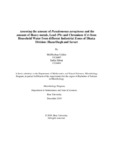| dc.contributor.advisor | Mosharraf, Fahareen Binta | |
| dc.contributor.author | Uddin, Md Raihan | |
| dc.contributor.author | Ishrat, Sadia | |
| dc.date.accessioned | 2020-08-31T10:43:44Z | |
| dc.date.available | 2020-08-31T10:43:44Z | |
| dc.date.copyright | 2019 | |
| dc.date.issued | 2019-12 | |
| dc.identifier.other | ID 15126007 | |
| dc.identifier.other | ID 15226001 | |
| dc.identifier.uri | http://hdl.handle.net/10361/14022 | |
| dc.description | This thesis is submitted in partial fulfilment of the requirements for the degree of Bachelor of Science in Microbiology, 2019. | en_US |
| dc.description | Catalogued from PDF version of thesis. | |
| dc.description | Includes bibliographical references (pages 38-45). | |
| dc.description.abstract | Water is the major natural reservoir of the atmosphere - not so much in volume as in time and
contact. Water is the indispensable environment resource for human security, the driven force
of engines of sustainable socioeconomic expansion. In recent days, due to presence of all types
of living organisms and undesirable accumulation of heavy metals in water and their toxic
impact on biological systems, the water quality is a concern of paramount prominence to ensure
the health of the population around the world. The purpose of this study was to determine the
quality of natural water including samples from reservoir and distribution by considering into
the microbiological aspect and several physicochemical analyses. Pseudomonas aeruginosa is
a bacterial species, which occurs widely in water environment capable of conferring wide range
of diseases and have tendency to develop high antibiotic resistance. The magnitude of the heavy
metals content of water may pose significant health risks so continuous monitoring of both
chemical and biological quality of natural water sources is highly recommended. The literature
cited here showed a parallel the assessment of the levels of the toxic chemicals like Lead (Pb)
and Chromium (Cr) in two distinct locations, Hazaribagh and Savar, Dhaka city within the
period of May2019- November 2019 along with the presence of Pseudomonas aeruginosa.
Finally, the results portrayed that 20% of the samples from each area confirmed the presence
of P.aeruginosa in the same sample as Lead that was present in 75% of the samples, whereas
chromium was absent in all the samples. | en_US |
| dc.description.statementofresponsibility | Md Raihan Uddin | |
| dc.description.statementofresponsibility | Sadia Ishrat | |
| dc.format.extent | 50 pages | |
| dc.language.iso | en_US | en_US |
| dc.publisher | Brac University | en_US |
| dc.rights | Brac University theses are protected by copyright. They may be viewed from this source for any purpose, but reproduction or distribution in any format is prohibited without written permission. | |
| dc.subject | Pseudomonas aeruginosa | en_US |
| dc.subject | Heavy metals | en_US |
| dc.subject | Lead (Pb) | en_US |
| dc.subject | Chromium (Cr) | en_US |
| dc.subject | Industrial zones | en_US |
| dc.subject | Household water | en_US |
| dc.subject | Dhaka Division | en_US |
| dc.subject.lcsh | Pseudomonas aeruginosa. | |
| dc.title | Assessing the amount of Pseudomonas aeruginosa and the amount of Heavy metals, Lead (Pb) and Chromium (Cr) from household water from different industrial zones of Dhaka Division (Hazaribagh and Savar) | en_US |
| dc.type | Thesis | en_US |
| dc.contributor.department | Department of Mathematics and Natural Sciences, Brac University | |
| dc.description.degree | B. Microbiology | |

